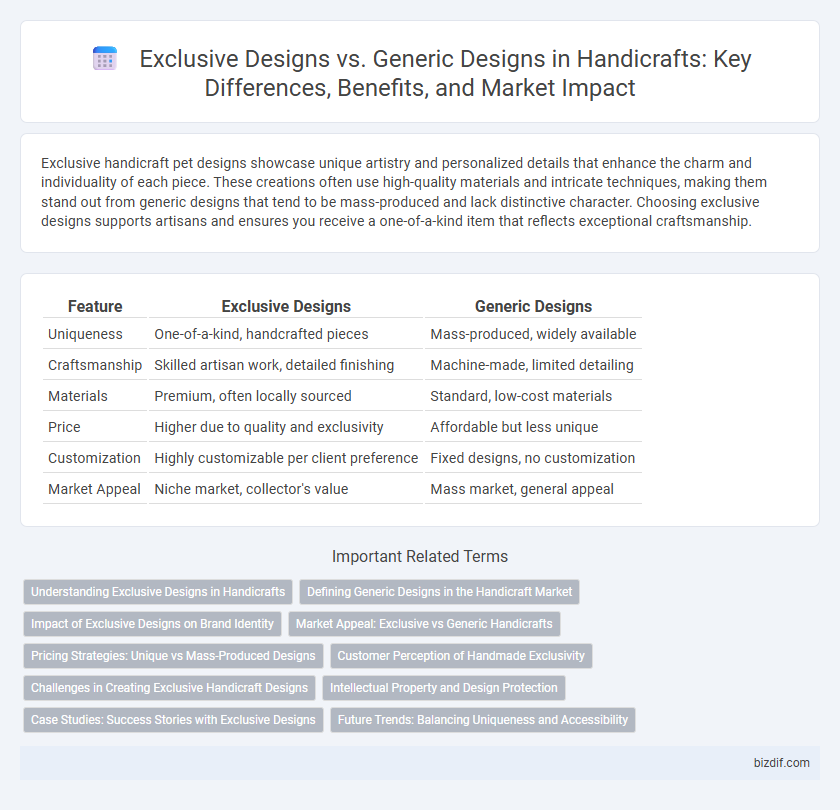Exclusive handicraft pet designs showcase unique artistry and personalized details that enhance the charm and individuality of each piece. These creations often use high-quality materials and intricate techniques, making them stand out from generic designs that tend to be mass-produced and lack distinctive character. Choosing exclusive designs supports artisans and ensures you receive a one-of-a-kind item that reflects exceptional craftsmanship.
Table of Comparison
| Feature | Exclusive Designs | Generic Designs |
|---|---|---|
| Uniqueness | One-of-a-kind, handcrafted pieces | Mass-produced, widely available |
| Craftsmanship | Skilled artisan work, detailed finishing | Machine-made, limited detailing |
| Materials | Premium, often locally sourced | Standard, low-cost materials |
| Price | Higher due to quality and exclusivity | Affordable but less unique |
| Customization | Highly customizable per client preference | Fixed designs, no customization |
| Market Appeal | Niche market, collector's value | Mass market, general appeal |
Understanding Exclusive Designs in Handicrafts
Exclusive designs in handicrafts emphasize unique, handcrafted elements that reflect cultural heritage and individual artisan creativity, setting them apart from mass-produced generic designs. These designs often incorporate intricate detailing and traditional techniques, enhancing their value and appeal in niche markets. Understanding exclusive designs involves recognizing their authenticity, craftsmanship quality, and the story behind each piece, which collectively contribute to their distinctiveness.
Defining Generic Designs in the Handicraft Market
Generic designs in the handicraft market refer to mass-produced patterns that lack unique artistic expression and cultural significance, often resulting in widespread availability and reduced market differentiation. These designs typically follow common motifs and standardized techniques, which diminish the perceived value and exclusivity sought by discerning customers. Understanding the characteristics of generic designs helps artisans emphasize originality and craftsmanship in order to elevate the distinctiveness of their products.
Impact of Exclusive Designs on Brand Identity
Exclusive designs in handicrafts significantly strengthen brand identity by showcasing unique craftsmanship and cultural heritage that distinguish the brand in a crowded market. These bespoke creations foster emotional connections with customers, leading to enhanced brand loyalty and premium pricing opportunities. By emphasizing originality and artistic skill, exclusive designs elevate brand perception and position the business as an innovator within the artisanal community.
Market Appeal: Exclusive vs Generic Handicrafts
Exclusive handicraft designs attract niche markets by offering unique, handcrafted items that emphasize creativity and cultural heritage, enhancing perceived value and customer loyalty. In contrast, generic designs appeal to mass markets due to their affordability and widespread availability but often lack distinctiveness and emotional connection. Market appeal shifts as consumers increasingly seek authenticity and personalized products, favoring exclusive handicrafts over generic ones.
Pricing Strategies: Unique vs Mass-Produced Designs
Exclusive handicraft designs often command premium pricing due to their uniqueness, handcrafted quality, and limited availability, appealing to niche markets willing to pay more for originality. In contrast, generic, mass-produced designs benefit from economies of scale, resulting in lower production costs and competitive pricing aimed at broader consumer segments. Pricing strategies for exclusive designs emphasize perceived value and artisanal craftsmanship, whereas generic designs rely on volume sales and cost efficiency.
Customer Perception of Handmade Exclusivity
Exclusive handmade designs are perceived by customers as unique, high-quality creations that reflect skilled craftsmanship and cultural authenticity, fostering a strong emotional connection. Generic designs are often seen as mass-produced and lack the personalized touch that defines true artisanal value, resulting in lower perceived worth and desirability. The appreciation for handmade exclusivity significantly influences customer preference, willingness to pay premium prices, and brand loyalty in the handicraft market.
Challenges in Creating Exclusive Handicraft Designs
Creating exclusive handicraft designs presents challenges such as sourcing unique materials that maintain authenticity while ensuring sustainability and affordability. Artisans face difficulties in balancing traditional craftsmanship with innovation to avoid replicating generic patterns that dilute cultural significance. Market demand pressures often limit experimentation, making it harder to introduce distinct designs that stand out in a competitive global marketplace.
Intellectual Property and Design Protection
Exclusive handicraft designs are protected under intellectual property laws such as copyrights and design patents, ensuring originality and preventing unauthorized reproduction. Generic designs often lack distinctiveness, making them difficult to safeguard legally and more vulnerable to imitation. Securing design protection enhances market value and reinforces brand identity for artisans, fostering innovation in the handicraft industry.
Case Studies: Success Stories with Exclusive Designs
Case studies reveal that exclusive designs in handicraft significantly boost brand identity and customer loyalty by offering unique artistic value unmatched by generic designs. Artisans showcasing exclusive craftsmanship have reported up to a 40% increase in sales, highlighting the premium consumers place on originality and cultural authenticity. Success stories from regions like Rajasthan and Oaxaca demonstrate how bespoke patterns not only preserve traditional techniques but also command higher market prices, driving sustainable economic growth for local communities.
Future Trends: Balancing Uniqueness and Accessibility
Future trends in handicraft emphasize a balance between exclusive designs that showcase artistic uniqueness and generic designs that offer broader accessibility. Advanced customization technologies and sustainable materials enable artisans to create personalized, limited-edition pieces that meet growing consumer demand for individuality. Market analysis predicts a rising preference for hybrid collections combining exclusivity with affordability, driving innovation in design processes and distribution channels.
Exclusive Designs vs Generic Designs Infographic

 bizdif.com
bizdif.com